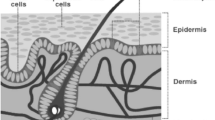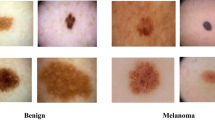Abstract
Skin Cancer is one of the acute diseases listed under top 5 groups in 2020 report of World Health Organisation. This research aims to propose a Convolutional Neural Network framework to extract and evaluate the suspicious skin region. This framework consists following phases; (i) Image collection and resizing, (ii) Suspicious skin section extraction using VGG-UNet, (iii) Deep-feature extraction, (iv) Handcrafted features mining from the suspicious skin section, (v) serial feature integration, and (vi) Classifier training and validation. This research considered dermoscopy images of International Skin Imaging Collaboration benchmark dataset for the experimental assessment and the result of the proposed framework is separately analysed for segmentation and classification tasks. In this work, benign and malignant class images are considered for the examination and during the classification task, integration of the deep and handcrafted features are considered. The experimental results of this study present a segmentation accuracy of > 98% with UNet and a classification accuracy of > 98% with VGG16 combined with Random Forest classifier.









Similar content being viewed by others
Explore related subjects
Discover the latest articles and news from researchers in related subjects, suggested using machine learning.References
Gloster HM Jr, Neal K (2006) Skin cancer in skin of color. J Am Acad Dermatol 55(5):741–760
Cheong KH, Tang KJW, Zhao X, Koh JEW, Faust O, Gururajan R, Acharya UR (2021) An automated skin melanoma detection system with melanoma-index based on entropy features. Biocybern Biomed Eng. 41(3):997–1012
Kadry S, Taniar D, Damaševičius R, Rajinikanth V, Lawal IA (2021) Extraction of abnormal skin lesion from dermoscopy image using VGG-SegNet. In: 2021 Seventh International Conference on Bio Signals, Images, and Instrumentation (ICBSII), IEEE, pp 1–5
Rajinikanth V, Raja NSM, Arunmozhi S (2019) ABCD rule implementation for the skin melanoma assesment–a study. In: 2019 IEEE International Conference on System, Computation, Automation and Networking (ICSCAN), IEEE, pp 1–4
Messadi M, Cherifi H, Bessaid A (2021) Segmentation and ABCD rule extraction for skin tumors classification. arXiv preprint arXiv:2106.04372.
Reimers C, Penzel N, Bodesheim P, Runge J, Denzler J (2021) Conditional dependence tests reveal the usage of ABCD rule features and bias variables in automatic skin lesion classification. In: Proceedings of the IEEE/CVF Conference on Computer Vision and Pattern Recognition, pp 1810–1819
Unlu E, Akay BN, Erdem C (2014) Comparison of dermatoscopic diagnostic algorithms based on calculation: the ABCD rule of dermatoscopy, the seven-point checklist, the three-point checklist and the CASH algorithm in dermatoscopic evaluation of melanocytic lesions. J Dermatol 41(7):598–603
Mishra R, Daescu O (2017) Deep learning for skin lesion segmentation. In: 2017 IEEE International Conference on Bioinformatics and Biomedicine (BIBM), IEEE, pp 1189–1194
Duggani K, Nath MK (2021) In: Khanna A, Gupta D, Pólkowski Z, Bhattacharyya S, Castillo O (eds) A technical review report on deep learning approach for skin cancer detection and segmentation, vol 54. Springer, Singapore. https://doi.org/10.1007/978-981-15-8335-3_9
Saba T (2021) Computer vision for microscopic skin cancer diagnosis using handcrafted and non-handcrafted features. Microsc Res Tech 84(6):1272–1283
Thanh DN, Prasath VB, Hieu LM, Hien NN (2020) Melanoma skin cancer detection method based on adaptive principal curvature, colour normalisation and feature extraction with the ABCD rule. J Digit Imaging 33(3):574–585
Wei L, Pan SX, Nanehkaran YA, Rajinikanth V (2021) An optimized method for skin cancer diagnosis using modified thermal exchange optimization algorithm. Comput Math Method Med. https://doi.org/10.1155/2021/5527698
Albahar MA (2019) Skin lesion classification using convolutional neural network with novel regularizer. IEEE Access 7:38306–38313
Kawahara J, Daneshvar S, Argenziano G, Hamarneh G (2018) Seven-point checklist and skin lesion classification using multitask multimodal neural nets. IEEE J Biomed Health Inform 23(2):538–546
Dorj UO, Lee KK, Choi JY, Lee M (2018) The skin cancer classification using deep convolutional neural network. Multimed Tool Appl 77(8):9909–9924
Mahbod A, Schaefer G, Ellinger I, Ecker R, Pitiot A, Wang C (2019) Fusing fine-tuned deep features for skin lesion classification. Comput Med Imaging Graph 71:19–29
Vasconcelos FFX, Medeiros AG, Peixoto SA, Reboucas Filho PP (2019) Automatic skin lesions segmentation based on a new morphological approach via geodesic active contour. Cogn Syst Res 55:44–59
Burlina PM, Joshi NJ, Ng E, Billings SD, Rebman AW, Aucott JN (2019) Automated detection of erythema migrans and other confounding skin lesions via deep learning. Comput Biol Med 105:151–156
Goyal M, Oakley A, Bansal P, Dancey D, Yap MH (2019) Skin lesion segmentation in dermoscopic images with ensemble deep learning methods. IEEE Access 8:4171–4181
Albert BA (2020) Deep learning from limited training data: novel segmentation and ensemble algorithms applied to automatic melanoma diagnosis. IEEE Access 8:31254–31269
Ahmad B, Usama M, Huang CM, Hwang K, Hossain MS, Muhammad G (2020) Discriminative feature learning for skin disease classification using deep convolutional neural network. IEEE Access 8:39025–39033
Adegun AA, Viriri S (2019) Deep learning-based system for automatic melanoma detection. IEEE Access 8:7160–7172
Song L, Lin J, Wang ZJ, Wang H (2020) An end-to-end multi-task deep learning framework for skin lesion analysis. IEEE J Biomed Health Inform 24(10):2912–2921
Wei L, Ding K, Hu H (2020) Automatic skin cancer detection in dermoscopy images based on ensemble lightweight deep learning network. IEEE Access 8:99633–99647
Kassem MA, Hosny KM, Fouad MM (2020) Skin lesions classification into eight classes for ISIC 2019 using deep convolutional neural network and transfer learning. IEEE Access 8:114822–114832
Öztürk Ş, Özkaya U (2020) Skin lesion segmentation with improved convolutional neural network. J Digit Imaging 33(4):958–970
Hosny KM, Kassem MA, Foaud MM (2020) Skin melanoma classification using ROI and data augmentation with deep convolutional neural networks. Multimed Tool Appl 79(33):24029–24055
Kassem MA, Hosny KM, Damaševičius R, Eltoukhy MM (2021) Machine learning and deep learning methods for skin lesion classification and diagnosis: a systematic review. Diagnostics 11(8):1390
Rahman T, Khandakar A, Kadir MA, Islam KR, Islam KF, Mazhar R, Chowdhury ME (2020) Reliable tuberculosis detection using chest X-ray with deep learning, segmentation and visualization. IEEE Access 8:191586–191601
Gutman D, Codella NCF, Celebi E, Helba B, Marchetti M, Mishra N, Halpern A (2016) Skin Lesion Analysis toward Melanoma Detection: A Challenge at the International Symposium on Biomedical Imaging (ISBI) 2016, hosted by the International Skin Imaging Collaboration (ISIC). eprint arXiv:1605.01397
Codella N, Gutman D, Celebi ME, Helba B, Marchetti MA, Dusza S, Kalloo A, Liopyris K, Mishra N, Kittler H, Halpern (2017) A Skin Lesion Analysis Toward Melanoma Detection: A Challenge at the 2017 International Symposium on Biomedical Imaging (ISBI), Hosted by the International Skin Imaging Collaboration (ISIC). arXiv:1710.05006 [cs.CV]
Soni M, Gomathi S, Kumar P, Churi PP, Mohammed MA, Salman AO (2022) Hybridizing convolutional neural network for classification of lung diseases. Int J Swarm Intell Res (IJSIR) 13(2):1–15
Mohammed MA, Ali IR, Obaid OI (2022) Diagnosing pilgrimage common diseases by interactive multimedia courseware. Baghdad Sci J 19(1):0168–0168
Zebari DA, Ibrahim DA, Zeebaree DQ, Mohammed MA, Haron H, Zebari NA, Maskeliūnas R (2021) Breast cancer detection using mammogram images with improved multi-fractal dimension approach and feature fusion. Appl Sci 11(24):12122
Zebari DA, Ibrahim DA, Zeebaree DQ, Haron H, Salih MS, Damaševičius R, Mohammed MA (2021) Systematic review of computing approaches for breast cancer detection based computer aided diagnosis using mammogram images. Appl Artif Intell. https://doi.org/10.1080/08839514.2021.2001177
Lahoura V, Singh H, Aggarwal A, Sharma B, Mohammed MA, Damaševičius R, Cengiz K (2021) Cloud computing-based framework for breast cancer diagnosis using extreme learning machine. Diagnostics 11(2):241
Ronneberger O, Fischer P, Brox T (2015) U-net: convolutional networks for biomedical image segmentation. In: International Conference on Medical Image Computing and Computer-Assisted Intervention, Springer, Cham, pp 234–241
Badrinarayanan V, Kendall A, Cipolla R (2017) Segnet: a deep convolutional encoder-decoder architecture for image segmentation. IEEE Trans Pattern Anal Mach Intell 39(12):2481–2495
Arunmozhi S, Sarojini VSS, Pavithra T, Varghese V, Deepti V, Rajinikanth V (2021) Automated detection of COVID-19 lesion in lung CT slices with VGG-UNet and handcrafted features. In: Digital future of healthcare, CRC Press, pp 185–200
Khan MA, Rajinikanth V, Satapathy SC, Taniar D, Mohanty JR, Tariq U, Damaševičius R (2021) VGG19 network assisted joint segmentation and classification of lung nodules in CT images. Diagnostics 11(12):2208
Fradi M, Zahzah EH, Machhout M (2022) Real-time application based CNN architecture for automatic USCT bone image segmentation. Biomed Signal Process Control 71:103123
Wróblewska A, Sysko-Romańczuk S, Prusinowski K (2020) Transfer dataset in image segmentation use case. In: International Conference on Neural Information Processing, Springer, Cham, pp 135–146
Rajinikanth V, Joseph Raj AN, Thanaraj KP, Naik GR (2020) A customized VGG19 network with concatenation of deep and handcrafted features for brain tumor detection. Appl Sci 10(10):3429
Ramzan M, Raza M, Sharif M, Khan MA, Nam Y (2021) Gastrointestinal tract infections classification using deep learning. Comput Mater Contin 69(3):3239–3257
Saba T, Khan MA, Rehman A et al (2019) Region extraction and classification of Skin Cancer: a heterogeneous framework of deep CNN features fusion and reduction. J Med Syst 43:289. https://doi.org/10.1007/s10916-019-1413-3
Khan MA, Sharif MI, Raza M, Anjum A, Saba T, Shad SA (2019) Skin lesion segmentation and classification: a unified framework of deep neural network features fusion and selection. Expert Syst. https://doi.org/10.1111/exsy.12497
Jaleel JA, Salim S, Aswin RB (2013) Computer aided detection of skin cancer. In: 2013 International Conference on Circuits, Power and Computing Technologies (ICCPCT), IEEE, pp 1137–1142
Maurya R, Singh SK, Maurya AK, Kumar A (2014) GLCM and multi class support vector machine based automated skin cancer classification. In: 2014 International Conference on Computing for Sustainable Global Development (INDIACom), IEEE, pp 444–447
Attallah O, Sharkas M (2021) Intelligent dermatologist tool for classifying multiple skin cancer subtypes by incorporating manifold radiomics features categories. Contrast Media Mol Imaging. https://doi.org/10.1155/2021/7192016
Mirniaharikandehei S, Heidari M, Danala G, Lakshmivarahan S, Zheng B (2021) A novel feature reduction method to improve performance of machine learning model. In: Medical imaging 2021: computer-aided diagnosis, Vol 11597. International Society for Optics and Photonics, p 1159726
Syed HH, Khan MA, Tariq U, Armghan A, Alenezi F, Khan JA, Rajinikanth V (2021) A rapid artificial intelligence-based computer-aided diagnosis system for covid-19 classification from ct images. Behav Neurol. https://doi.org/10.1155/2021/2560388
Arshad M, Khan MA, Tariq U, Armghan A, Alenezi F, Younus Javed M, Kadry S (2021) A computer-aided diagnosis system using deep learning for multiclass skin lesion classification. Comput Intell Neurosci. https://doi.org/10.1155/2021/9619079
Meraj T, Alosaimi W, Alouffi B, Rauf HT, Kumar SA, Damaševičius R, Alyami H (2021) A quantization assisted U-Net study with ICA and deep features fusion for breast cancer identification using ultrasonic data. PeerJ Comput Sci 7:e805
Author information
Authors and Affiliations
Corresponding author
Additional information
Publisher's Note
Springer Nature remains neutral with regard to jurisdictional claims in published maps and institutional affiliations.
Rights and permissions
About this article
Cite this article
Cheng, X., Kadry, S., Meqdad, M.N. et al. CNN supported framework for automatic extraction and evaluation of dermoscopy images. J Supercomput 78, 17114–17131 (2022). https://doi.org/10.1007/s11227-022-04561-w
Accepted:
Published:
Issue Date:
DOI: https://doi.org/10.1007/s11227-022-04561-w
Keywords
Profiles
- Maytham N. Meqdad View author profile




